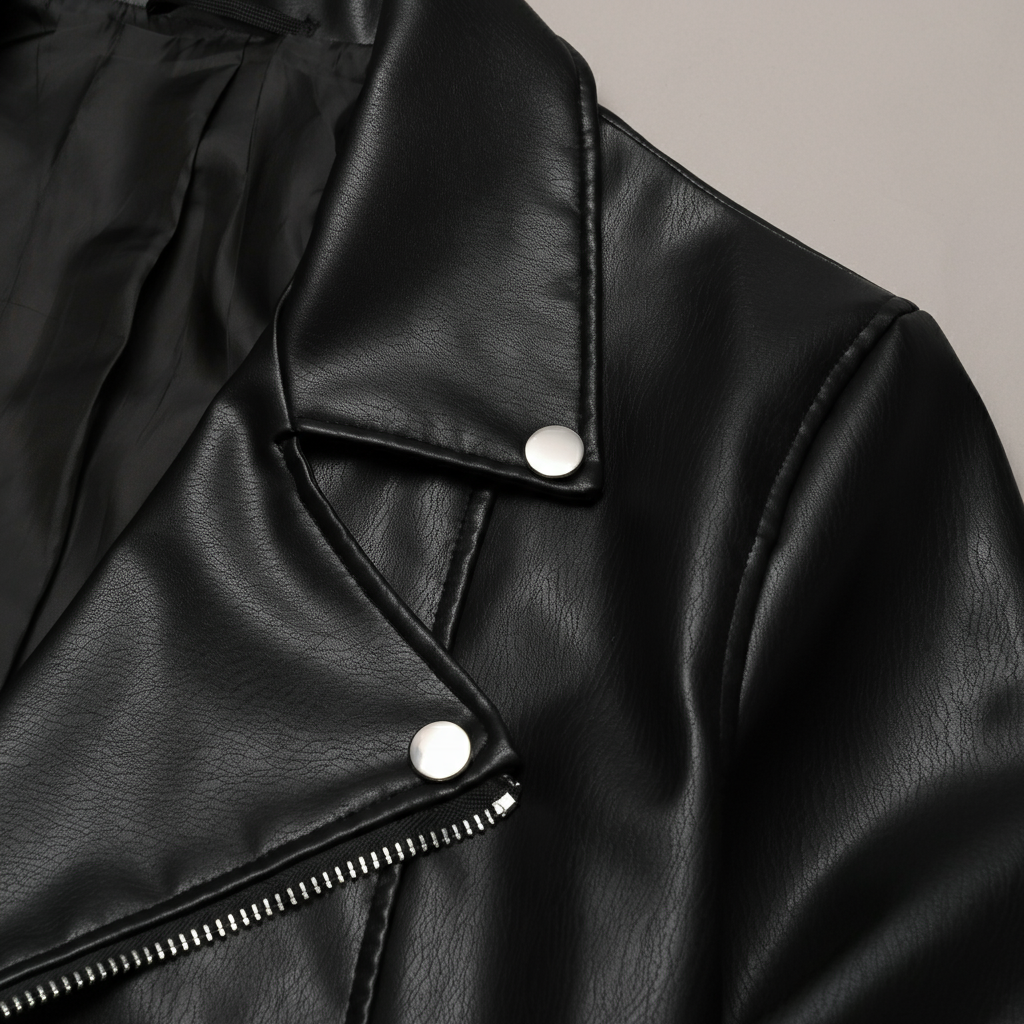Have you ever looked at a stylish jacket, a sleek handbag, or a modern piece of furniture and wondered how it could be so affordable yet look so much like real leather? Chances are, you were looking at PU leather. This material has become incredibly popular in fashion and home goods, offering a great alternative to traditional animal hide. But what exactly is it?
This guide will walk you through everything you need to know about PU leather. We will explore how it’s made, its pros and cons, and how it compares to other materials like genuine leather and faux leather. By the end, you will be an expert on this versatile fabric and can make informed choices for your wardrobe and home.
Key Takeaways
- What it is: PU leather is a completely artificial material made from a type of plastic called polyurethane, which is applied to a fabric backing. It contains no animal products, making it a type of vegan leather.
- Benefits: It’s significantly more affordable than genuine leather, water-resistant, easy to clean, and available in a wide variety of colors and styles.
- Drawbacks: It is less durable and breathable than real leather. It can also be prone to cracking or peeling over time and is not as environmentally friendly as some natural alternatives.
- Care: To maintain PU leather, clean it with a damp cloth and mild soap. Avoid harsh chemicals, direct sunlight, and extreme heat to prevent damage.
Decoding PU Leather: What Is It, Exactly?
PU leather is short for polyurethane leather. It’s an entirely man-made material designed to mimic the look and feel of genuine leather. Unlike some other “pleather” or faux leather types that might contain leather scraps, PU leather is 100% artificial. This makes it a true vegan leather, as no animal products are used in its production.
The creation process involves coating a base fabric—usually polyester, cotton, or nylon—with a flexible polymer called polyurethane. This plastic coating is then treated and textured to replicate the grain and appearance of real animal hide. The result is a material that can look surprisingly similar to the real thing but comes with a very different set of properties and a much lower price tag. You’ll find it used in everything from affordable fashion accessories and clothing to upholstery for chairs and couches.
How is PU Leather Made?
Understanding how PU leather is made helps to see why it has the properties it does. The process is a fascinating blend of textile manufacturing and polymer chemistry.
- Creating the Base: It all starts with a fabric base layer. This is typically a synthetic fiber like polyester because of its durability and low cost, but sometimes cotton or rayon is used. This base provides the structure and strength for the final material.
- Applying the Polyurethane: Next, a liquid form of polyurethane (PU) is applied to the fabric base. This can be done in one or more layers. This plastic coating is what gives the material its leather-like appearance and feel.
- Embossing the Texture: While the polyurethane is still pliable, it’s run through rollers that emboss it with a texture. This is the crucial step that creates the grain pattern you see on the surface. Manufacturers can create a wide range of textures, from the smooth finish of nappa leather to the pebbled look of full-grain hide.
- Finishing Touches: Finally, additional treatments might be applied to give the material a specific color, sheen, or protective quality. This is how PU leather can be produced in virtually any color imaginable, from classic browns and blacks to vibrant reds and blues.
This industrial process is highly controlled, allowing for consistency and a wide range of aesthetic possibilities that are often difficult to achieve with natural leather.
The Pros and Cons of PU Leather
Like any material, PU leather has its own set of advantages and disadvantages. Knowing these can help you decide if it’s the right choice for your needs, whether you’re buying a new pair of boots or a sofa.
Advantages of Choosing PU Leather
PU leather has gained popularity for several compelling reasons, making it a go-to choice for many consumers and manufacturers.
Cost-Effective Alternative
One of the biggest draws of PU leather is its price. It is significantly cheaper to produce than genuine leather, which requires raising animals, tanning hides, and skilled labor. This cost saving is passed on to the consumer, making products like jackets, shoes, and furniture much more accessible and affordable.
Easy Maintenance and Cleaning
PU leather is non-porous thanks to its plastic coating. This means it doesn’t absorb water or stains the way real leather does. Spills can be easily wiped away with a damp cloth, making it a practical choice for items that see a lot of use, like dining chairs or handbags. It doesn’t require special conditioners or treatments to keep it looking good.
Vegan and Animal-Friendly
For ethical consumers, PU leather is a clear winner. Since it’s 100% synthetic, no animals are harmed in its creation. This has made it a staple in the vegan fashion movement, offering a cruelty-free way to achieve a leather look. Many brands now proudly market their PU products as “vegan leather.”
Versatility in Style and Color
The manufacturing process allows for incredible versatility. PU leather can be made in any color, from classic neutrals to bold, trendy hues. It can also be finished with different sheens (matte, satin, high-gloss) and textures, allowing designers to create a vast array of styles that might be impossible or prohibitively expensive with real leather.
Disadvantages to Consider
While there are many benefits, there are also some notable downsides to PU leather that you should be aware of before making a purchase.
Durability and Lifespan
PU leather is not as durable as genuine leather. Over time and with frequent use, the polyurethane coating can start to crack, peel, or flake away from the fabric base. It’s also more susceptible to punctures and tears. While a real leather jacket might last for decades, a PU leather item typically has a lifespan of just a few years.
Lacks Breathability
The plastic coating that makes PU leather water-resistant also makes it non-breathable. Unlike genuine leather, which has natural pores, PU leather traps heat and moisture. This can make clothing items like jackets or pants feel clammy and uncomfortable to wear for long periods, especially in warmer weather.
Environmental Impact
While it is animal-friendly, the environmental footprint of PU leather is a concern. It’s derived from fossil fuels (a non-renewable resource), and its production involves solvents and other chemicals. Furthermore, because it’s a type of plastic, it is not biodegradable and can contribute to microplastic pollution as it breaks down.
PU Leather vs. The Competition
It’s easy to get confused by all the different “leather” terms out there. Let’s break down how PU leather stacks up against genuine leather and other common alternatives.
PU Leather vs. Genuine Leather
This is the classic comparison. While they can look similar at a glance, they are fundamentally different materials with distinct characteristics.
|
Feature |
PU Leather |
Genuine Leather |
|---|---|---|
|
Source |
100% synthetic (polyurethane plastic) |
Natural animal hide |
|
Cost |
Low |
High |
|
Durability |
Lower; can crack or peel over time |
Very high; develops a patina with age |
|
Breathability |
Low; can feel hot and clammy |
High; very breathable and comfortable |
|
Maintenance |
Easy to clean with a damp cloth |
Requires conditioning and special care |
|
Aging |
Wears out, deteriorates |
Ages beautifully, becomes softer |
|
Scent |
A chemical or plastic smell |
A distinct, natural, earthy smell |
|
Environmental |
Fossil-fuel based, not biodegradable |
Involves animal agriculture and tanning |
As you can see, the choice often comes down to budget, durability needs, and ethical considerations. For those wanting a long-term investment piece that ages gracefully, genuine leather is superior. For affordable, trendy, or vegan options, PU leather is an excellent choice. You can find more style comparisons and tips on the truefashionstory.comBlog.
PU Leather vs. Faux Leather (Pleather)
The terms “faux leather” and “pleather” are often used interchangeably, but there can be subtle differences. “Faux leather” is a broad umbrella term for any artificial leather. PU leather is one type of faux leather.
Another common type is PVC leather (polyvinyl chloride). PVC is less flexible and less breathable than PU. It was more common in the past but is used less frequently today in fashion because PU offers a more realistic feel and is slightly better from an environmental standpoint (it doesn’t produce dioxins like PVC can). When someone says “pleather,” they could be referring to either PU or PVC leather.
PU Leather vs. Bi-Cast Leather
This is where things get tricky. Bi-cast leather (or bycast leather) is not fully synthetic. It’s made using the lower, split-grain part of a real leather hide—the part that’s left over after the top grain is removed. This split-grain base is then coated with a layer of polyurethane, just like PU leather.
So, bi-cast leather has a real leather core but a plastic surface. This makes it more affordable than top-grain leather but slightly more expensive than pure PU leather. However, it suffers from some of the same durability issues as PU, with the surface being prone to peeling. It is not considered vegan because it contains animal products.
How to Care for Your PU Leather Items
Proper care can extend the life of your PU leather goods and keep them looking their best. The good news is that maintenance is very simple.
- Regular Cleaning: For general dust and dirt, simply wipe the surface with a soft, dry, or slightly damp cloth.
- Spot Treating Stains: For spills or stains, mix a small amount of mild dish soap with warm water. Dip a soft cloth in the solution, wring it out, and gently wipe the stain. Follow up with a cloth dampened with plain water to remove any soap residue, then pat dry.
- Avoid Harsh Chemicals: Never use bleach, alcohol-based cleaners, or abrasive scrubs on PU leather. These will strip the polyurethane coating and cause it to dry out and crack.
- Storage: Store PU leather items in a cool, dry place away from direct sunlight. UV rays can cause the material to fade and become brittle over time. If storing clothing, use a breathable garment bag instead of a plastic one to prevent moisture buildup.
Frequently Asked Questions (FAQ)
Is PU leather waterproof?
PU leather is highly water-resistant, but not completely waterproof. The plastic coating will repel water, so spills bead up on the surface and can be wiped away easily. However, the seams can still let water in, and if submerged, water can eventually penetrate the material.
Does PU leather peel?
Yes, peeling is one of the main drawbacks of PU leather. Over time, with wear and tear, exposure to sunlight, and bending, the polyurethane layer can start to separate from the fabric base, causing it to crack and peel.
Is PU leather considered good quality?
Quality can vary. High-quality PU leather can look and feel very convincing and hold up reasonably well for a few years. Low-quality versions may look obviously plastic and can start to peel or crack very quickly. It is generally not considered as high-quality or as long-lasting as genuine leather.
Can you repair cracked PU leather?
Minor cracks can sometimes be repaired using a vinyl and leather repair kit. These kits come with a color-matched filler compound that you can apply to the damaged area. However, for extensive peeling or large cracks, a repair is often difficult and may not look seamless.
Conclusion: Is PU Leather Right for You?
PU leather is a fantastic material that has earned its place in the market. It provides an affordable, stylish, and cruelty-free alternative to genuine leather, making it accessible to a wide range of consumers. Its versatility in color and texture allows for endless design possibilities in fashion, accessories, and home decor.
However, it’s important to be realistic about its limitations. It lacks the durability, breathability, and luxurious aging process of real leather, and its environmental impact is a valid concern for some.
Ultimately, the decision to buy PU leather depends on your priorities. If you are looking for a budget-friendly, trendy item, need something easy to clean, or are committed to a vegan lifestyle, PU leather is an excellent choice. Just be prepared for a shorter lifespan compared to a genuine leather investment piece. By understanding what PU leather is and how it behaves, you can shop smarter and choose the products that best fit your lifestyle and values.





